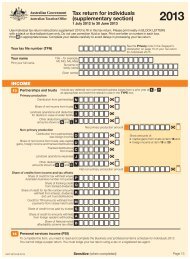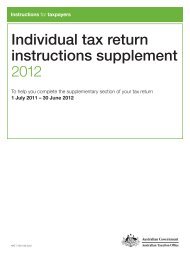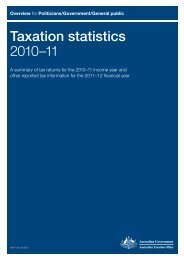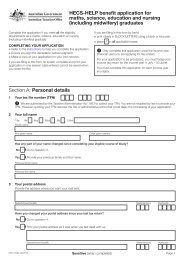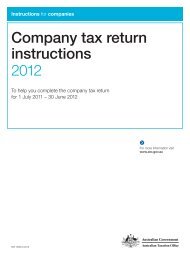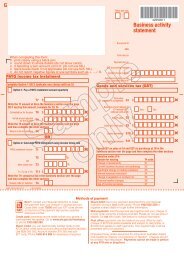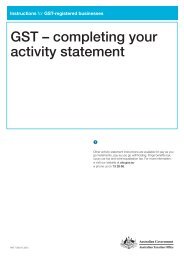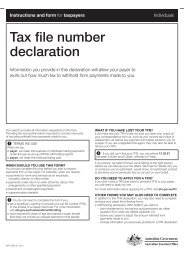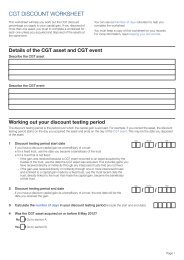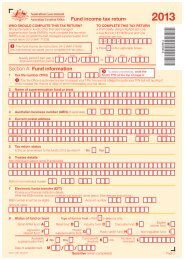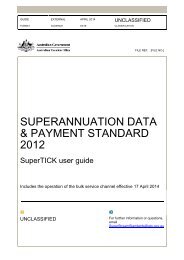EXAMPLE: Sale of a <strong>depreciating</strong> asset used partlyfor a taxable purpose, ignoring any GST impactAndrew sells a computer for $600. The computer’s costis $1,000. It has been used 40% of the time for privatepurposes. At the time of its sale, the computer’s adjustablevalue is $700.Andrew can claim a deduction of $60. This is 60%(the proportion of use for a taxable purpose) of thebalancing adjustment amount (the difference betweenthe computer’s termination value and its adjustable valueat the time of its sale).In addition, a capital loss of $160 arises. This is 40%(the proportion of use for a non-taxable purpose) of thedifference between the computer’s termination value andits cost.Leisure facilities and boatsIf a balancing adjustment event occurs for a <strong>depreciating</strong>asset that is a leisure facility or a boat and your deductions forthe decline in value of the asset have been reduced (see Declinein value of leisure facilities on page 8, and Decline in value ofboats on page 8) the balancing adjustment amount is reduced <strong>to</strong>the extent your deductions for decline in value were reduced. Inaddition, a capital gain or capital loss may arise in respect of thedifference between the asset’s cost and its termination value thatis attributable <strong>to</strong> the reduction.These rules are similar <strong>to</strong> those for working out the balancingadjustment amount for a <strong>depreciating</strong> asset used for anon‐taxable purpose.Plant acquired before 21 September 1999and other <strong>depreciating</strong> <strong>assets</strong> acquiredbefore 1 July 2001Any assessable balancing adjustment amount or capital gain(if the asset was used for a non-taxable purpose) may bereduced if a balancing adjustment event occurs for:n an item of plant that was acquired before 11.45am (by legaltime in the ACT) on 21 September 1999, orn a <strong>depreciating</strong> asset acquired before 1 July 2001 that isnot plant.The amount of the reduction is the cost base of the asset forCGT purposes less its cost. The purpose of this reduction is<strong>to</strong> preserve CGT cost base advantages for <strong>assets</strong> acquiredbefore these dates.One reason that the cost base might exceed the cost isindexation of the cost base. There is indexation of the costbase <strong>to</strong> 30 September 1999 where:n a CGT event happens <strong>to</strong> an asset acquired before 11.45am(by legal time in the ACT) on 21 September 1999, andn the asset was owned for 12 months or more.Indexation is not available for <strong>assets</strong> for which capital gainsand capital losses are disregarded; see Depreciating assetused for a non-taxable purpose on the previous page fora list of such <strong>assets</strong>. However, the balancing adjustmentamount is reduced if the asset is:n a car that is designed <strong>to</strong> carry a load of less than one <strong>to</strong>nneand fewer than nine passengersn a mo<strong>to</strong>r cyclen a valour decorationn a collectable (such as a painting or an antique) if the firstelement of its cost is $500 or lessn an asset acquired before 20 September 1985, orn an asset used solely <strong>to</strong> produce exempt income.In these cases, the balancing adjustment amount is reducedby the difference between the asset’s termination valueand its cost that is attributable <strong>to</strong> the use of the asset fora taxable purpose.See the <strong>Guide</strong> <strong>to</strong> capital gains tax <strong>2013</strong> for moreinformation about indexation of a cost base and the impac<strong>to</strong>f indexation on discount capital gains.Balancing adjustment rules for carsIf a balancing adjustment event occurs for your car, you need <strong>to</strong>work out any balancing adjustment amount. Special rules apply<strong>to</strong> the calculation of balancing adjustment amounts for cars.If a balancing adjustment event occurs for a car you usedfor a non-taxable purpose, you disregard any capital gainor capital loss.If you use the one-third of actual expenses method or thelogbook method of claiming car expenses, your balancingadjustment amount needs <strong>to</strong> be reduced by the amount thatis attributable <strong>to</strong> the use of the car for a non-taxable purpose.EXAMPLE: If you use the one-third of actualexpenses method, ignoring any GST impactLouise acquired a car on 1 July 2011. During both the2011–12 and 2012–13 income years, Louise used theone-third of actual expenses method <strong>to</strong> work out herdeductions for car expenses. She sold her car for $24,500on 30 June <strong>2013</strong>. At that time, the adjustable value of thecar was $18,200.Louise’s balancing adjustment amount is reduced by theamount attributable <strong>to</strong> her use of the car for a non-taxablepurpose. As she used the one-third of actual expensesmethod <strong>to</strong> work out her deductions for car expenses, herbalancing adjustment amount is reduced by two-thirds.Louise’s balancing adjustment would be $2,100, that is,one-third of the difference ($6,300) between the terminationvalue and the adjustable value of the car. Louise mustinclude the amount of $2,100 in her assessable income.EXAMPLE: If you use the logbook method,ignoring any GST impactIf Louise used the logbook method <strong>to</strong> work out herdeductions for car expenses and her logbook showedthat the level of her business use was 40%, her balancingadjustment amount would be $2,520. This is 40% of thedifference between the termination value and the adjustablevalue of the car ($6,300 × 40% = $2,520). Louise mustinclude the amount of $2,520 in her assessable income.20 a<strong>to</strong>.gov.au GUIDE TO DEPRECIATING ASSETS <strong>2013</strong>
If you have only used the cents per kilometre method orthe 12% of original value method of claiming car expenses,no balancing adjustment amount arises because the declinein value of the car is not worked out separately under thosemethods. The decline in value is taken in<strong>to</strong> account as par<strong>to</strong>f the calculation of the car expenses. However, if you switchbetween these methods and the one-third of actual expensesmethod or the logbook method of claiming car expenses,you may have <strong>to</strong> work out a balancing adjustment amount.This is only expected <strong>to</strong> occur in a limited number of cases. Ifyou are affected and you are unsure of how <strong>to</strong> work out yourbalancing adjustment amount, contact us or your recognisedtax adviser.For a car subject <strong>to</strong> the car limit (see Car limit on page 15)you need <strong>to</strong> reduce the termination value. You multiply thetermination value by the following fraction:car limit +amounts included in the car’ssecond element of cost<strong>to</strong>tal cost of the carwhere the <strong>to</strong>tal cost of the car is the sum of the first andsecond elements of cost, ignoring the car limit and after anyadjustments for input tax credits; see GST input tax creditson page 15. You use the reduced termination value <strong>to</strong> workout your balancing adjustment amount for the car.If a car was acquired at a discount and the cost of the carwas increased by a discount portion, the termination value ofthe car must also be increased by that discount portion; seeCar acquired at a discount on page 15.If you are a lessee under a luxury car lease or a hirer under ahire purchase agreement and you do not acquire the car whenthe lease or agreement terminates or ends, you are treated asif you had sold the asset <strong>to</strong> the lessor or financier, respectively.You will need <strong>to</strong> work out any assessable or deductiblebalancing adjustment amount.Involuntary disposal of a <strong>depreciating</strong> assetAn involuntary disposal occurs if a <strong>depreciating</strong> asset is:n lost or destroyedn compulsorily acquired by an entity (other than a foreigngovernment agency)n disposed of <strong>to</strong> an entity (other than a foreign governmentagency) after they served a notice on you inviting you <strong>to</strong>negotiate a sale agreement. They must have informedyou that, if negotiations are unsuccessful, the asset will becompulsorily acquired either under an <strong>Australian</strong> law, otherthan chapter 6A of the Corporations Act 2001 or under aforeign law, other than the equivalent of chapter 6A of theCorporations Act 2001.n fixed <strong>to</strong> land that is disposed of <strong>to</strong> an entity (other thana foreign government agency) where a mining leasewas compulsorily granted over the land and the leasesignificantly affected (or would have significantly affected)your use of the land, and the entity <strong>to</strong> which you disposedof the land is the lessee.You may offset an assessable balancing adjustment amountarising from an involuntary disposal against the cost of one ormore replacement <strong>assets</strong>. If you offset an amount against thecost of a replacement asset for an income year after the onein which the replacement asset’s start time occurs, you mustalso reduce the sum of its opening adjustable value plus anysecond elements of its cost for that later year.You must incur the expenditure on the replacement asset, orstart <strong>to</strong> hold it, no earlier than one year before the involuntarydisposal and no later than one year after the end of theincome year in which that disposal occurred.The Commissioner can agree <strong>to</strong> extend the time limit, forexample, if it is unlikely that insurance claims for the disposalof the original asset will be settled within the required timeeven though you have taken all reasonable steps <strong>to</strong> have theinsurance claims settled.To offset the assessable balancing adjustment amount,the replacement asset must be wholly used, or installedready for use, by you for a taxable purpose at the end ofthe income year in which you incurred the expenditure onthe asset or you started <strong>to</strong> hold it, and you must be able <strong>to</strong>deduct an amount for it.Rollover reliefIf rollover relief is available under the UCA rules, no balancingadjustment amount arises when a balancing adjustment even<strong>to</strong>ccurs for a <strong>depreciating</strong> asset. In some cases, rollover reliefis au<strong>to</strong>matic, for example, transfers pursuant <strong>to</strong> a court orderfollowing a marriage breakdown.In some cases, rollover relief must be chosen. If the eventarises from a change in the holding of, or in interests in, apartnership asset such as a variation in the constitution of apartnership or in a partnership interest, the transferor and thetransferee must jointly choose the rollover relief.Rollover relief may be available if you cease <strong>to</strong> hold a vesselcovered by a certificate issued under Part 2 of the ShippingReform (Tax Incentives) Act 2012. If the available relief ischosen, only the balancing adjustment amount that exceedsthe cost of acquiring another certified vessel is included inassessable income.When rollover relief applies, the transferee of the <strong>depreciating</strong>asset can claim deductions for the asset’s decline in value asif there had been no change in holding.The transferee must use the same method that the transferorused <strong>to</strong> work out the decline in value of the asset.If the transferor used the diminishing value method, thetransferee must also use the same effective life that thetransferor was using.If the transferor used the prime cost method, the transfereemust replace the asset’s effective life in the prime cost formulawith the asset’s remaining effective life, that is, any periodof the asset’s effective life that is yet <strong>to</strong> elapse when thetransferor s<strong>to</strong>pped holding the asset.The first element of cost for the transferee is the adjustablevalue of the asset when it was held by the transferor justbefore the balancing adjustment event occurred.There are specific record-keeping requirements for rolloverrelief; see Record keeping for rollover relief on page 35.For the 2007–08 income year and later years the roll-overrelief available under the UCA rules has been extended <strong>to</strong>small business entities that choose <strong>to</strong> claim their capitalallowance deductions under the simplified depreciationrules; see Small business entities on page 32.GUIDE TO DEPRECIATING ASSETS <strong>2013</strong> a<strong>to</strong>.gov.au 21



